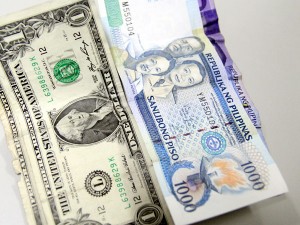The peso should stay above 40 to a dollar to help ensure the Philippines will keep its robust-growth momentum, according to Socioeconomic Planning Secretary Arsenio Balisacan.
Balisacan, who is also director general of the National Economic and Development Authority (Neda), said the recent depreciation of the peso to the 43:$1 level would eventually prove to be a boon to the economy. He said this would help boost exports, improve competitiveness of locally produced goods and further fuel consumption of households dependent on remittances.
The peso last year and in the first quarter of this year was one of the fastest appreciating currencies against the dollar on the back of significant foreign capital inflows.
While a 40-to-a-dollar rate would still be tolerable, Balisacan said an exchange rate stronger than that could derail efforts to boost the country’s competitiveness.
“I wouldn’t want to see the peso appreciating to 37 or 38, or simply the 30s (to a dollar) territory. That would hurt local industries,” Balisacan said.
He said measures that could prevent a sharp appreciation of the peso would be prudent, citing the government’s inclination toward borrowing more from domestic sources. This would be a good strategy not only to minimize exposure to foreign-exchange risks but also to help avoid a sharp appreciation of the local currency, he added.
With less foreign borrowings, dollar inflows are tempered and the peso is kept from significant appreciation.
The government decided not to borrow from foreign, commercial sources of credit this year. It said all funding requirements will be met mostly through the sale of government securities in the domestic market.
“The current level of the peso is fine,” Balisacan said.
The weakening of the peso back to the 43-to-a-dollar level followed an increase in the appetite for the greenback amid speculations that the US Federal Reserve would soon end its stimulus program, under which it buys enormous amounts of bonds to inject liquidity and boost the American economy.
Liquidity arising from the bond purchases partly spilled over to emerging markets like the Philippines in the form of foreign portfolio investments. A withdrawal of the stimulus is seen to eventually cause emerging market currencies to depreciate. Such speculations prompted some fund owners to shift to the dollar.
Balisacan said the depreciation of the peso was beneficial and would complement efforts to make the robust economic growth of the Philippines sustainable.
The local economy grew by 7.8 percent in the first quarter from a year ago, registering the fastest growth rate in Asia.


